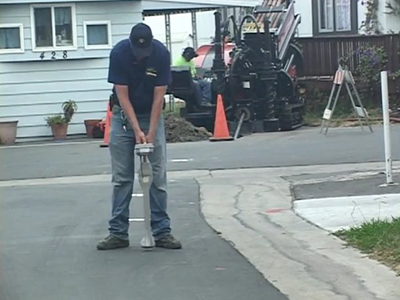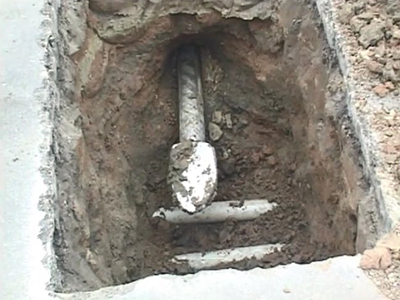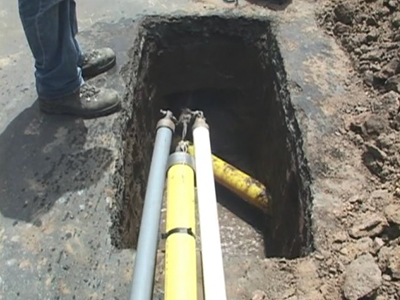If you need to replace your water, gas, electric, telephone and cable TV lines, you realize the enormous task you have ahead. The prospect of tearing up your streets, landscaping, and sidewalks is no simple matter. However, there is another way: underground directional drilling.
Horizontal directional drilling (HDD) is revolutionizing the way underground utilities are installed in manufactured home communities. Trenching through streets and landscape to install underground utilities is outdated. HDD is a safer, more environmentally friendly and less costly method of installing underground utilities in congested areas.
Management companies are discovering that HDD reduces, and even eliminates many negative aspects that are associated with old-fashioned trenching such as construction noise, dust pollution, road closures, and blocked parking.
In addition, management companies have been hard pressed to find ways to cut the cost of utility replacement. HDD reduces restoration costs, road closure permits, use of barricades, concrete cutting, hauling off spoil, disposal fees, compacting backfill, resurfacing, reseeding, and sunken trenches. When comparing the cost and quality of HDD vs. trenching, HDD is a “no brainer.”
Taking First Steps
Before drilling, preparations must be made to ensure that the drilling can be completed safely and quickly. The exact location and depth of all existing underground utilities that lie in the path of the drill must be determined. “Potholing” is accomplished by electronically locating and physically exposing existing utilities to determine their depth.
The location and depth of the existing utilities are noted on a drill plan, which is a scaled drawing of a predetermined drill path and its relationship to existing underground utilities. The drill plan shows the best drilling route to install a new utility and indicates steps that must be taken to avoid contact with existing underground utilities. The drill plan, in effect, serves as a map by which to drill.
HDD eliminates the army of workers and equipment needed to dig up streets because HDD requires only two men: an operator to run the drilling machine and a tracker to electronically track and steer the drilling as it proceeds underground. The HDD machine is a miniaturized version of an oil-drilling platform turned sideways so that it can drill horizontally. While an operator runs the drill machine a tracker monitors and marks the exact location of the drilling progress.
The HDD machine is packed with sophisticated electronics and operates with an immensely powerful hydraulic drilling motor. The HDD operator controls the internal functions of the machine, such as drill speed, drill pipe rotation, thrust and pull back pressure. In addition, the operator must monitor an onboard display that provides very precise measures of depth and the direction of a steerable drill head. This information comes from a transmitter located inside the drill head.
The drill head transmitter relays its exact depth and direction not only to a receiver onboard the HDD machine, but also to another receiver held by the tracker. The tracker, walking directly above the drill head as it drills, can monitor its direction and depth.
To steer the drill head, the tracker signals the operator to drill up and down and left or right to avoid underground utilities. Drilling can be accurately guided underground for long distances, avoiding existing utilities while maintaining depth and direction. Bores up to 1,000 feet in length can be successfully completed to install water, gas, electric, telephone, cable TV and fiber optic.
Gaining in Use and Popularity
Support for HDD is widespread. Public works authorities such as the Housing and Community Development Department (HCD) and Caltrans recognize the value of HDD because of social benefits, reduced construction costs, and improved quality of the job. Engineers also maintain that HDD installations can lead to longer utility life because the HDD utility is installed in a relatively undisturbed environment.
Management companies realize that torn up yards, closed streets, and increased time to complete a project, add to the cost of the job. They also understand that trenching reduces pavement life. By not tearing up roadways and landscape, utilities installed by HDD will garner a higher level of resident satisfaction. They appreciate that with HDD installations there is no ground settling and sunken ditches commonly associated with trenching.
The advantages to HDD over trenching are obvious. Trenching is slow and tedious, requiring more patience than experience on multiple projects. In contrast, HDD installs quickly and with minimal surface disruption, resulting in fewer problems with residents. Residents are also pleased to see major construction projects installed with little or no aggravation to them.
HDD machinery is not for everyone. Besides expensive equipment to purchase, the directional drilling machine and the electronics equipment required to operate the system are very sophisticated and technical. Operating HDD machinery safely and productively requires extensive training and drilling time.
Because every bore is different, becoming proficient at HDD requires a learning curve. You must accumulate drilling expertise through drilling experience. Inexperienced HDD crews, those early in their “learning curve” phase, almost always get themselves into trouble by drilling into existing utilities. The carbide tipped drilling head used in HDD can drill through the hardest of soils as well as existing utility lines.
The manufactured home community management is a tight-knit field. If you are considering HDD in your community, consult management companies who have used HDD. You can eliminate the “learning curve” problem by choosing an HDD contractor with the experience to manage the project.



